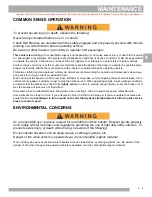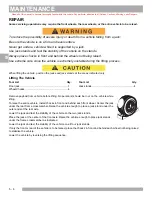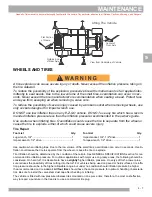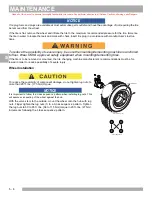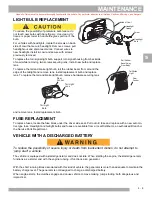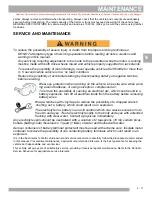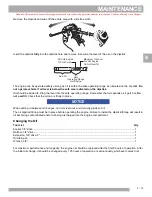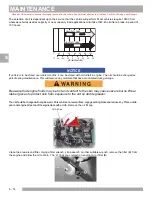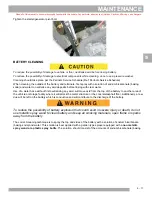
5 - 19
MAINTENANCE
Read all of this manual to become thoroughly familiar with this vehicle. Pay particular attention to all Notices, Cautions, Warnings, and Dangers.
5
Periodic Brake Test For Mechanical Brakes
The purpose of this test is to compare the braking performance of the vehicle to the braking performance of new or
‘known to be good’ vehicles or to an established acceptable stopping distance. Actual stopping distances will be
influenced by weather conditions, terrain, road surface condition, actual vehicle weight (accessories installed) and
vehicle speed. No specific braking distance can be reliably specified. The test is conducted by latching the park
brake to eliminate different pedal pressures and to include the affects of linkage mis-adjustment.
Establish the acceptable stopping distance by testing a new or ‘known to be good’ vehicle and recording the stopping
location or stopping distance. For fleets of vehicles, several vehicles should be tested when new and the range of
stopping locations or distances recorded.
Over time, a subtle loss of performance may take place; therefore, it is important to establish the standard with a new
vehicle.
Drive the vehicle at maximum speed on a flat, dry, clean, paved surface. Quickly depress the brake pedal to latch the
parking brake at the line or marker in the test area and remove foot from pedal. The vehicle should stop aggres-
sively. The wheel brakes may or may not lock. Observe the vehicle stopping location or measure the vehicle stop-
ping distance from the point at which the brakes were latched. The vehicle should stop within the ‘normal’ range of
stopping distances. If the vehicle stops more than 4 ft. (1.2 m) beyond the acceptable stopping distance or pulls to
one side, the vehicle has failed the test and should be tested again.
If the vehicle fails the second test, it should
immediately
be removed from service. The vehicle
must
be inspected
by a qualified mechanic who should refer to the TROUBLESHOOTING section in the Technician’s Repair and Ser-
vice Manual.
AIR INTAKE AND COOLING FINS
To prevent possible burns, engine parts should be kept clean to reduce risk of overheating and
ignition of accumulated debris. After every off road use, allow to cool and then check for a build
up of dirt and debris in the air intake and cooling fins. Dirt and debris may clog the engine’s air
cooling system. Clean areas shown to prevent engine damage. Keep linkages, springs and con-
Latch
Parking Brake
and Take Foot
Off Pedal
Line or Marker
Acceptable
Stopping
Distance
Normal Range of
Stopping Distance
Any vehicles that stop
more than 4 ft. (1.2 m)
beyond the Acceptable
Stopping Distance or
pulls to one side should
be removed from service
and inspected by a
qualified mechanic
Accelerate To
Maximum Speed
4 ft. (1.2 m)
Line or Marker
Dry, Level, Clean, Paved Surface
NOTICE
Содержание 622010
Страница 1: ...622010 Owner s Guide ISSUED JULY 2011...
Страница 75: ......

